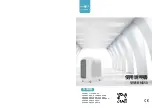
Installation and Commissioning Guide - MultiElite 2 Split System
Doc. No. 9590-5009
Ver. 1 211221
6
Installation and Commissioning Guide
Multi Split System
05. Installation Information
All service technicians handling this unit must be licensed to handle R-32 refrigerant.
Recover and Recycle Refrigerants
Never release refrigerant to the atmosphere! It is an offence in Australia to do so. Always recover, recycle and reuse
refrigerants. When removing from the system, properly contain and identify refrigerants in its dedicated container for
proper disposal and/or storage. Always consider the recycle or reclaim requirements of the refrigerant before beginning
the recovery procedures. Obtain a chemical analysis of the refrigerant if necessary. For the recovered refrigerant and
acceptable refrigerant quality refer to the existing standards and regulations.
Refrigerant Handling and Safety
Consult the refrigerant manufacturer’s Material Safety Data Sheet (MSDS) for information on proper handling and to
fully understand health, safety, storage and disposal requirements. Use the approved containment vessels and refer to
appropriate safety standards. Comply with all applicable transportation standards when shipping refrigerant containers.
Service Equipment and Recovery Procedures
Always use refrigerant reclaiming equipment in order to minimise refrigerant emissions. Use equipment and methods
which will pull the lowest possible system vacuum while recovering and condensing refrigerant. Equipment capable of
pulling a vacuum of less than 500 microns is required.
Do not open the system to the atmosphere for service work until refrigerant is fully removed and/or recovered. Perform
refrigeration system evacuation, prior to charging, in accordance with AIRAH / IRHACE Refrigerant handling code of
practice.
Let the unit stand for 1 hour and with the vacuum not rising above 500 microns. A rise above 500 microns indicates a leak
from the system and a leak test is required to locate and repair any leak.
Charge refrigerant into the system only after the equipment does not leak or contain moisture. Take into consideration
the correct amount of refrigerant charge specified for the system to ensure efficient unit operations. When charging
is complete, reclaim refrigerant from charging lines into an approved refrigerant container. Seal all used refrigerant
containers with approved closure devices to prevent unused refrigerant from escaping to the atmosphere. Take extra
care to maintain all service equipment directly supporting refrigerant service work such as gauges, hoses, vacuum pumps
and recycling equipment.
INSTALLATION PREPARATION (Pre-Installation considerations)
The following items must be considered before beginning the unit installation:
•
Verify the unit capacities and ratings with the unit nameplate.
•
Make certain the floor or foundation is level, solid and has sufficient structural strength to support the unit and
accessories weight.
•
Install anti-vibration rubber (installer to supply) under
all of the unit’s feet
to help reduce noise and minimize
vibration transfer through the foundation. Ensure that all anti-vibration rubbers are rated to provide stable support
without impairing the unit’s structural integrity.
•
Diameter or width of anti-vibration rubber’s must be at least equal to the width of the actual feet to prevent
deformation overtime.
•
Allow minimum recommended clearances for periodic maintenance and service access.
•
Allow sufficient space beside the unit for the outdoor air discharge. Condenser air inlet, located on the coil side of the
unit, requires sufficient airflow clearance for the optimum unit performance.
•
Note the conditioned supply air and return air location. Ensure sufficient spaces are allocated for these purposes.
•
For the connection and location of condensate drain in the unit, refer to the drawings and dimensions section of this
manual.
•
Wiring connections must be in accordance with the wiring diagram provided with the unit.
•
Make sure all wirings are in accordance with local electricity authority regulations and standards.
•
Do not install the unit close to an area where there is a danger of fire due to volatile, explosive, flammable and/ or
hazardous materials.
•
Ensure that spaces around the unit are free from any obstructions for optimum unit performance.







































